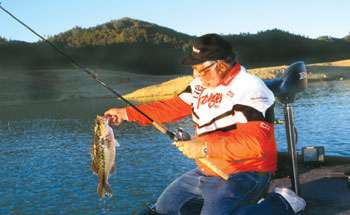
No angler in the world is more closely associated with finesse doodling than California’s Don Iovino (www.iovino.com). He was singing the praises of this technique at least three decades ago, and he isn’t changing his tune now.
“Since I found that shaking the rod tip with live (or dead) bait seemed to increase the number of bites I got, I never gave it a second thought that the same thing wouldn’t work with my new hand-poured plastic worms,” he says while discussing the origins of his techniques.
Tackle matters to Iovino. He begins with a specialty rod made by Lamiglas. It has a soft, flexible tip and a stiff, heavy butt. He prefers Ardent reels. “They are made in America, have great reliability and quality and are reasonably priced. They don’t give me a minute’s trouble.”
But, unlike many of his fellow professionals, he doesn’t spool with fluorocarbon. “It’s too stiff and too sensitive. I prefer Maxima monofilament in the lighter test weights. It’s never given me any problems, so I don’t see any reason to change,” he explains.
Iovino’s opinions about rigging are equally well-defined. He begins by slipping a Top Brass worm weight up his line. Below that he’ll peg an 8mm glass bead to the line with a Top Brass rubber nail. (Don’t throw away the trimmings.)
Two or three inches below that he’ll tie a thin-wire Owner Mosquito hook. To his hook he’ll attach a smallish — 4 1/2- to 6-inch — hand-poured plastic worm. Don’t shortchange the gap between the bead and the hook. It lets the worm dance and move naturally.
5 Dos for Doodling
1. Find your target first. “Doodling is usually the best method in one of two situations — on structure breaks, or off structure as in fish being suspended, but still related to an edge.” The only way to find and mark such spots is with quality electronics. Iovino’s choice is Lowrance.
2. Know when to slide. “On the breaks and on the bottom are two fundamental situations for the straight doodle. But in the early spring or late fall with dropping water conditions, the doodle ‘slide’ is more effective.” (A straight doodle is defined as fishing on the bottom. A doodle slide, on the other hand, is defined as fishing an imaginary horizontal line above the bottom.)
3. Develop a rhythm. “Bouncing the sliding sinker on or above the bottom and making the worm dance or wiggle like the real thing requires a rhythmic shaking of the rod tip.”
4. Keep your worm in place. “Insert a short piece of the rubber nail trimmings through the eye of the hook before you pull it into the plastic. That’ll hold the worm in place.”
5. Learn to feel the bite. “It feels like you’re stretching a rubber band. In fact I recommend anglers stretch a rubber band back and forth on their way to the water to get used to the feel.”
If you’re serious about finesse fishing, read Iovino’s book, Finesse Bass Fishing: The Sonar Connection. It can be ordered through his Web site: www.iovino.com.




